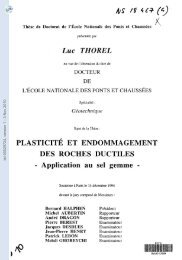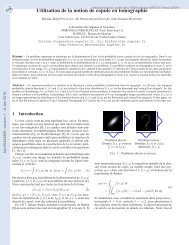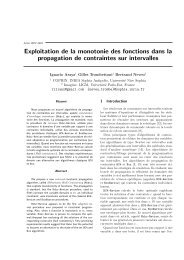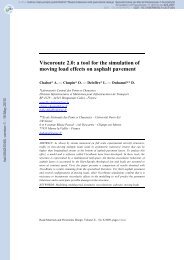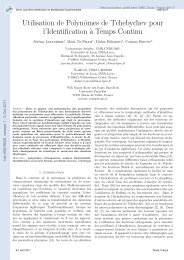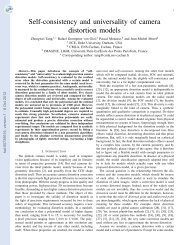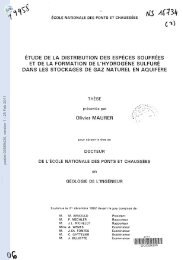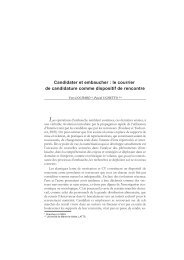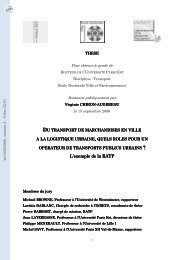MULTIVARIATE POLYNOMIALS IN SAGE
MULTIVARIATE POLYNOMIALS IN SAGE
MULTIVARIATE POLYNOMIALS IN SAGE
You also want an ePaper? Increase the reach of your titles
YUMPU automatically turns print PDFs into web optimized ePapers that Google loves.
MULTIVARIABLE <strong>POLYNOMIALS</strong> <strong>IN</strong> <strong>SAGE</strong> 3<br />
From these simple operators s i , we can now define the divided difference operators. For<br />
type A, we have:<br />
f∂ i :=<br />
f − f s i<br />
x i − x i+1<br />
(9)<br />
fπ i := x if − x i+1 f s i<br />
x i − x i+1<br />
= f.(x i ∂ i ) (10)<br />
f ˆπ i := (f − f s i<br />
)x i+1<br />
= f.(π i − 1)<br />
x i − x i+1<br />
(11)<br />
fT i := f.(π i (t 1 + t 2 ) − s i t 2 ) (12)<br />
hal-00824143, version 1 - 21 May 2013<br />
for 1 ≤ i ≤ n − 1. ∂ i is the Newton divided difference, π i and ˆπ i are the isobaric divided<br />
differences and T i is the generator of the Hecke algebra H 2 . As the s i satisfy the braid<br />
relations, all the above operators do.<br />
If v i > v i+1 , the Newton divided difference ∂ i can be seen as an operator decrementing<br />
the vector degree and summing over all the intermediate monomials between<br />
x (...,v i−1,v i+1 ,...) and x (...,v i+1,v i −1,...) . For example,<br />
x (4,1) ∂ 1 = x (3,1) + x (2,2) + x (1,3) . (13)<br />
When v i < v i+1 , one just needs to switch v i and v i+1 , multiply by −1 and do the previous<br />
operation. When v i = v i+1 , the result is 0. This description can be used to give a more<br />
general, type-free definition. We can see the vectors indexing the monomials as elements<br />
of the ambient space of the root system of type A n−1 . The above ∂ i operation can then<br />
be seen as a formal sum of vectors, adding factors of the simple root (. . . , −1, 1 . . .) to<br />
the original vector. The sign of v i − v i+1 is given by the scalar product between the<br />
vector and the i th simple coroot of the ambient space. This definition is equivalent to<br />
the previous one. We can use it to define our divided differences in types B, C, and<br />
D, using the root systems of respective types B n , C n , and D n . Compared to type A,<br />
we add the n th simple root and coroot whose definition depends on the type and create<br />
the n th divided difference operator:<br />
∂n B = 1 − sB n<br />
x 1 2 n − x − 1 2<br />
n<br />
∂n C =<br />
1 − sC n<br />
x n − x −1<br />
n<br />
(14)<br />
(15)<br />
∂ D n = 1 − sD n<br />
x −1<br />
n−1 − x n<br />
(16)<br />
The same construction can be done with the isobaric divided differences π and ˆπ.<br />
2.3. Linear bases. We can now use these operators to define linear bases of the ring of<br />
multivariate polynomials. Let (x 1 , x 2 , . . . , x n ) and (y 1 , y 2 , . . . , y n ) be two sets of variables<br />
and λ a partition of length n, i.e., λ 1 ≥ λ 2 ≥ . . . ≥ λ n . We then define dominant



